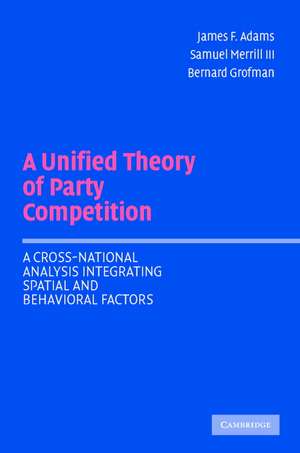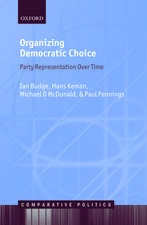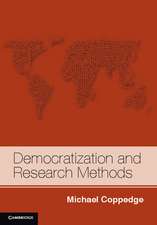A Unified Theory of Party Competition: A Cross-National Analysis Integrating Spatial and Behavioral Factors
Autor James F. Adams, Samuel Merrill III, Bernard Grofmanen Limba Engleză Paperback – 20 mar 2005
| Toate formatele și edițiile | Preț | Express |
|---|---|---|
| Paperback (1) | 281.77 lei 43-57 zile | |
| Cambridge University Press – 20 mar 2005 | 281.77 lei 43-57 zile | |
| Hardback (1) | 673.61 lei 43-57 zile | |
| Cambridge University Press – 20 mar 2005 | 673.61 lei 43-57 zile |
Preț: 281.77 lei
Nou
Puncte Express: 423
Preț estimativ în valută:
53.92€ • 56.44$ • 44.88£
53.92€ • 56.44$ • 44.88£
Carte tipărită la comandă
Livrare economică 31 martie-14 aprilie
Preluare comenzi: 021 569.72.76
Specificații
ISBN-13: 9780521544931
ISBN-10: 0521544939
Pagini: 332
Ilustrații: 44 tables
Dimensiuni: 152 x 230 x 21 mm
Greutate: 0.46 kg
Editura: Cambridge University Press
Colecția Cambridge University Press
Locul publicării:New York, United States
ISBN-10: 0521544939
Pagini: 332
Ilustrații: 44 tables
Dimensiuni: 152 x 230 x 21 mm
Greutate: 0.46 kg
Editura: Cambridge University Press
Colecția Cambridge University Press
Locul publicării:New York, United States
Cuprins
1. Modeling party competition; 2. How voters decide: the components of the unified theory of voting; 3. Linking voter choice to party strategies: illustrating the role of non-policy factors; 4. Factors influencing the link between party strategy and the variables; 5. Policy competition under the unified theory: empirical applications to the 1988 French Presidential Election; 6. Policy competition under the unified voting model: empirical applications to the 1989 Norwegian parliamentary election; 7. The threat of abstention: candidate strategies and policy representation in US presidential elections; 8. Candidate strategies with voter abstention in US presidential elections: 1980, 1984, 1988, 1996, and 2000; 9. Policy competition in Britain: the 1997 general election; 10. The consequences of voter projection: assimilation and contrast effects; 11. Policy-seeking motivations of parties in two-party elections: theory; 12. Policy-seeking motivations of parties in two-party elections: empirical analysis; 13. Concluding remarks.
Notă biografică
Descriere
This book explains how parties and candidates locate themselves on the Left-Right ideological dimension.










